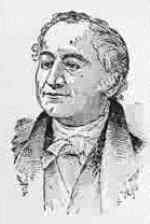John Rutherfurd
| John Rutherfurd | |
|---|---|
 | |
| United States Senator from New Jersey | |
|
In office March 4, 1791 – December 5, 1798 | |
| Preceded by | Jonathan Elmer |
| Succeeded by | Franklin Davenport |
| Member of the New Jersey General Assembly | |
|
In office 1789–1790 | |
| Personal details | |
| Born |
September 20, 1760 New York City, New York |
| Died |
February 23, 1840 (aged 79) New Jersey |
| Political party | Federalist |
John Rutherfurd (September 20, 1760 – February 23, 1840) was an American politician and land surveyor. He represented New Jersey in the United States Senate from 1791 to 1798.
Early life
John Rutherfurd was born in New York City. His parents were Walter and Mary (Alexander) Rutherfurd. Walter was a veteran of the British Army, and was a hostage of Patriots during the Revolutionary War while John was a teenager. Walter died in 1804. Mary was a sister of William Alexander Lord Stirling. He was also related to Gilbert Elliot-Murray-Kynynmound, 4th Baronet; William Eden, 1st Baron Auckland; Newfoundland Governor John Elliott; General/Ohio territorial Governor Arthur St. Clair
Education and politics
Rutherfurd attended the College of New Jersey (now Princeton University) and studied law. He practiced law in New York City for several years, and then moved to a farm near the village of Tranquility in Sussex County (after a boundary for a new county was drawn in 1824 his former holdings straddled Sussex and Warren Counties) in New Jersey in 1787. He entered politics, serving in the New Jersey General Assembly from 1788 to 1790. He was then elected as a Federalist to the United States Senate from New Jersey and served in the Senate from 1791 to 1798.
Retirement from politics
Rutherfurd then retired from politics, but he was to undertake several important projects during the rest of his life. He was one of the three Commissioners who laid out the plans for the Manhattan street grid north of 14th Street from 1807 to 1811. Around 1816 he investigated the building of a possible canal connecting the Delaware, Raritan and Hudson rivers. Finally, from 1827 to 1833, he helped settle New Jersey's boundaries with New York and Pennsylvania.
In 1808, Rutherfurd moved with his family to a farm on the banks of the Passaic River near what is now Rutherford, New Jersey. He lived at this place for the rest of his life, naming it "Edgerston", and died there. Rutherfurd had a large family. He was married to Helena Morris Rutherfurd from 1782 until his death in 1840, and Helena died shortly after him. They had eight children. (Helena was the daughter of Congressman Lewis Morris).
One of John Rutherfurd's sons, Robert Walter Rutherfurd, was a member of the New Jersey State Legislature. One of Robert's sons, and John's grandson, was the astronomer Lewis Morris Rutherfurd.
The town of Rutherford, New Jersey was named at least in part after John Rutherfurd, who had owned much of the land during his life. However, the spelling was changed due to the fame of President Rutherford B. Hayes who was President of the United States during the 1870s when the town was created.
External links
- United States Congress. "John Rutherfurd (id: R000550)". Biographical Directory of the United States Congress.
| United States Senate | ||
|---|---|---|
| Preceded by Jonathan Elmer |
U.S. Senator (Class 1) from New Jersey 1791–1798 Served alongside: Philemon Dickinson, Frederick Frelinghuysen, Richard Stockton |
Succeeded by Franklin Davenport |
| Honorary titles | ||
| Preceded by Paine Wingate |
Most Senior Living U.S. Senator (Sitting or Former) March 7, 1838 – February 23, 1840 |
Succeeded by Albert Gallatin |
Guide to the John Rutherfurd Papers, 1726-1835
